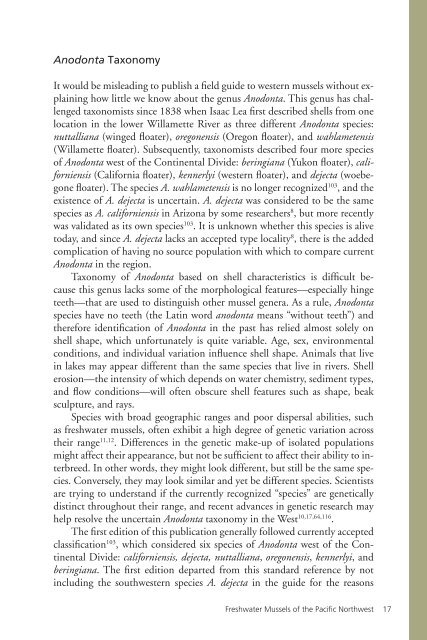Freshwater Mussels Pacific Northwest - The Xerces Society
Freshwater Mussels Pacific Northwest - The Xerces Society
Freshwater Mussels Pacific Northwest - The Xerces Society
Create successful ePaper yourself
Turn your PDF publications into a flip-book with our unique Google optimized e-Paper software.
Anodonta Taxonomy<br />
It would be misleading to publish a field guide to western mussels without explaining<br />
how little we know about the genus Anodonta. This genus has challenged<br />
taxonomists since 1838 when Isaac Lea first described shells from one<br />
location in the lower Willamette River as three different Anodonta species:<br />
nuttalliana (winged floater), oregonensis (Oregon floater), and wahlametensis<br />
(Willamette floater). Subsequently, taxonomists described four more species<br />
of Anodonta west of the Continental Divide: beringiana (Yukon floater), californiensis<br />
(California floater), kennerlyi (western floater), and dejecta (woebegone<br />
floater). <strong>The</strong> species A. wahlametensis is no longer recognized 103 , and the<br />
existence of A. dejecta is uncertain. A. dejecta was considered to be the same<br />
species as A. californiensis in Arizona by some researchers 8 , but more recently<br />
was validated as its own species 103 . It is unknown whether this species is alive<br />
today, and since A. dejecta lacks an accepted type locality 8 , there is the added<br />
complication of having no source population with which to compare current<br />
Anodonta in the region.<br />
Taxonomy of Anodonta based on shell characteristics is difficult because<br />
this genus lacks some of the morphological features—especially hinge<br />
teeth—that are used to distinguish other mussel genera. As a rule, Anodonta<br />
species have no teeth (the Latin word anodonta means “without teeth”) and<br />
therefore identification of Anodonta in the past has relied almost solely on<br />
shell shape, which unfortunately is quite variable. Age, sex, environmental<br />
conditions, and individual variation influence shell shape. Animals that live<br />
in lakes may appear different than the same species that live in rivers. Shell<br />
erosion—the intensity of which depends on water chemistry, sediment types,<br />
and flow conditions—will often obscure shell features such as shape, beak<br />
sculpture, and rays.<br />
Species with broad geographic ranges and poor dispersal abilities, such<br />
as freshwater mussels, often exhibit a high degree of genetic variation across<br />
their range 11,12 . Differences in the genetic make-up of isolated populations<br />
might affect their appearance, but not be sufficient to affect their ability to interbreed.<br />
In other words, they might look different, but still be the same species.<br />
Conversely, they may look similar and yet be different species. Scientists<br />
are trying to understand if the currently recognized “species” are genetically<br />
distinct throughout their range, and recent advances in genetic research may<br />
help resolve the uncertain Anodonta taxonomy in the West 10,17,64,116 .<br />
<strong>The</strong> first edition of this publication generally followed currently accepted<br />
classification 103 , which considered six species of Anodonta west of the Continental<br />
Divide: californiensis, dejecta, nuttalliana, oregonensis, kennerlyi, and<br />
beringiana. <strong>The</strong> first edition departed from this standard reference by not<br />
including the southwestern species A. dejecta in the guide for the reasons<br />
<strong>Freshwater</strong> <strong>Mussels</strong> of the <strong>Pacific</strong> <strong>Northwest</strong> 17

















